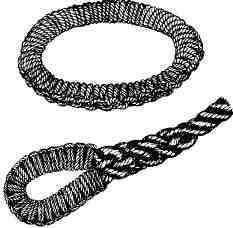![[Ringbolt Hitching]](../archive/archgraph/ringbolt/ringbol1.jpg)
RINGBOLT HITCHING:

-
Description ----
-
A series of interlocking lark's head knot that form a ridge around the outside of a ring or loop.
-
Use ----
-
To prevent chafing; as a decoration.
-
Comments ----
-
There are many forms of ringbolt hitching, the form shown here is one of the simplest and does not require the use of a needle as many other forms do. Ringbolt hitching was used to prevent chafing of ropes that were reeved through hand forged iron rings and to keep them from clanging against objects around them. In the present, ringbolt hitching can be used to protect synthetic ropes that are easily chafed by a applying a layer of material that is not easily chafed.
-
Other Names ----
-
Platted Ring; Hog Backing; Cockscombing.
-
Narration ------ (For Ringbolt Hitching knotboard.)
-
(1) Start the ringbolt hitching by tying a half knot around the object. (2) Tie a half hitch around the object so that the standing end is trapped under the half hitch. (3) pull the half hitch tight. (4) Tie the next half hitch in the opposite direction around the object. (5) Pull the half hitch tight. (6) Tie another half hitch in the opposite direction around the object; the same direction as the first half hitch. (7) Pull half hitch tight. (8) When the length of the ringbolt hitching is within 5 or 6 half hitches of being long enough; form a bight in the a short piece of twine so that the eye of the bight is toward the end of the work. (9) Continue to add half hitches until the ringbolt hitching is completed; reeve the running end through the eye of the bight. (10) Use the short piece of twine to pull the running end under the half hitches. (11) Cut off the end of the twine.


![[Ringbolt Hitching]](../archive/archgraph/ringbolt/ringbol1.jpg)
